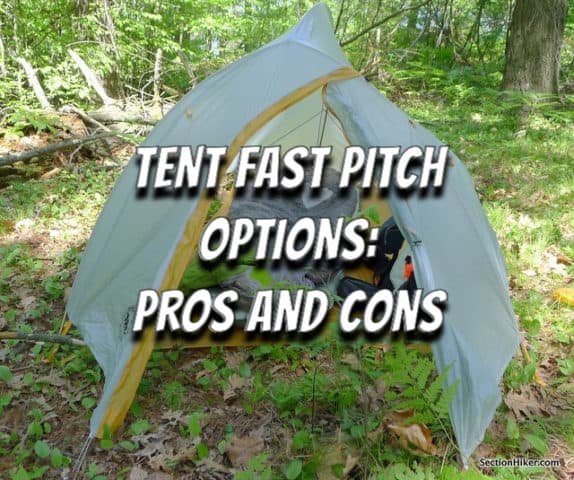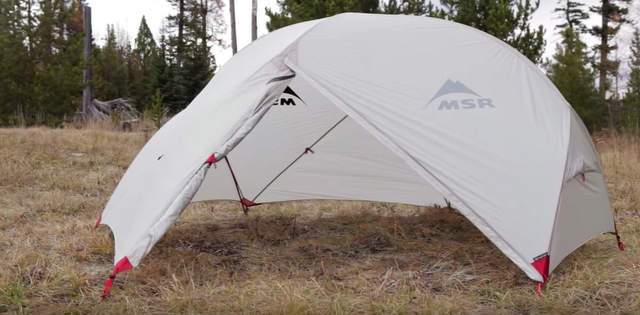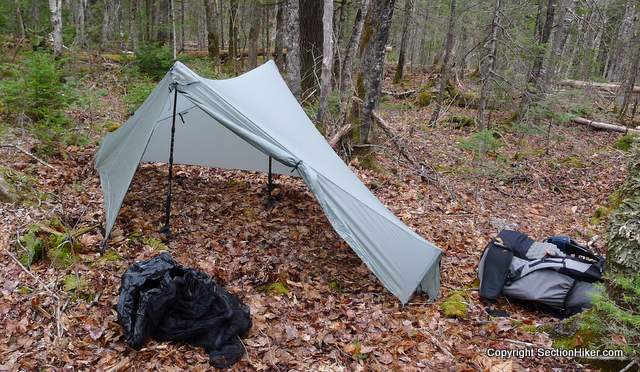 “You need to buy the tent footprint if you want the fast pitch option,” is the common refrain of tent manufacturers and retailers. But you wonder, “When would I use the fast pitch option and what am I giving up if I don’t buy the footprint now?”
“You need to buy the tent footprint if you want the fast pitch option,” is the common refrain of tent manufacturers and retailers. But you wonder, “When would I use the fast pitch option and what am I giving up if I don’t buy the footprint now?”
Many double-wall tent manufacturers promote a fast fly or fast pitch option which lets you set up the rain fly with a footprint instead of the inner mesh tent as a weight saving option, when you don’t need the insect protection or creepy-crawly protection (spiders, scorpions, and snakes) it provides. The inner tents on most lightweight 2-person double-wall tents weigh close to 16 ounces, so this can save you a serious amount of gear weight in the right circumstances.
For example on the Big Agnes Fly Creek (shown above), you’d stake down the footprint, open and insert the multi-segment pole tips into the footprint’s corner grommets, and then drape your rain fly over the poles and connecting it to the footprint’s corner connectors. For added strength, you can wrap the velcro connectors on the underside of the rain fly to the poles. While the resulting structure isn’t as sturdy, windproof, or rain-proof as it is when using the inner tent, it provides a tarp-like structure that provides light weather protection for well protected campsites.
When would you use a fast pitch option like this? You could use it for short backpacking trips where you’re confident of favorable weather or anyplace where you might cowboy camp, but still want a lightweight shelter for just-in-case morning dew or light rain protection. You can also use it as a sun shade if you’re hiking in the desert. The good thing about the fast pitch option is that you don’t need trees or trekking poles to set it up, like a tarp.
- No trees or trekking poles required to pitch rain fly
- No extra long guylines or knot knowledge required like a tarp
- Makes a good sun shelter when shade is unavailable
- Provide protection against heavy dew and light drizzle
- Provides increased privacy over most tarp setups
Despite these advantages, fast fly options that require a footprint are fairly limited. While they do provide limited protection in light rain, there’s usually a substantial gap between the footprint and the bottom edge of the rain fly that lets let wind-blown rain enter the tent or drip on to the footprint. They also provide little protection from wind-blown sand, dust, or snow.

Fast Pitch Options that Don’t Require Footprints
Some tents don’t require the purchase of footprint to set up the rainfly. For example, the MSR Hubba Hubba NX rain fly can be set up without a footprint, although you also have the option of purchasing a footprint and setting it up with one if you want the added benefit of a groundsheet. The problem with these footprint-free setups is that they tend to be structurally weaker than footprint-based fast fly pitches, because the only thing supporting them are tent stakes. Still they are less expensive than footprint-based fast fly pitches because you don’t have the added cost of a tent footprint.
Fast and Light Tent Bodies
MSR also offers a new fast and light tent body (see the SectionHiker Review) that is an inner tent without the insect netting and overcomes the structural deficiencies of footprint-based fast fly options. It also solves the issue of rain splatter and drips onto the footprint floor suffered by fast fly options that require footprints. They’re heavy though and represent little weight savings compared to using a footprint-based solution. They also cost a lot more than a footprint.
Fly First Tents
There are also tents available that let you pitch the rain fly first, before you set up the inner tent. Once the rain fly is set up, you can crawl underneath it to get out of the weather and hang the inner tent by hooks suspended from the rain fly’s ceiling. This is a pretty common option in European-made double-wall tents from companies like Hilleberg. Tarptent also sells many tents with this capability.

The main benefit of a fly-first pitch is the ability to set the tent up in the rain without getting the inner tent wet. Some of these fly-first tent pitches are also quite structurally strong, particularly those where the poles slot into sleeves sewn to the rain fly instead of being connected using velcro strips.
Popular tents that fall into this category include:
Wrap Up
I’ve illustrated a number of different approaches that tent manufacturers offer for setting up a rain fly without requiring an inner tent:
- Footprint-based fast fly options
- Footprint-free fast fly options
- Fast and light tent bodies
- Fly-first tents
In terms of value, the best option for using a rain fly alone is to purchase what I’ve called a fly-first tent, where the rain fly can be set up by itself or before the inner tent. These tend to be strong and weather worthy, even when the rain fly is used alone. While they can be expensive, you get two fully functional tents for the price of one, when used with or without the inner tent.
While MSR’s new fast and light tent bodies solve the structural inadequacies of footprint-based and footprint-free fast fly options, they provide very little weight savings for the cost.
Footprint-based fast fly options provide the least value however because they’re so limited by location or the time of year (insect-free) when you can use them. While buying a footprint that matches your tent can make sense if you camp on abrasive ground and have a very thin tent floor, it doesn’t make sense to buy a tent footprint so you can use a tent’s footprint-based fast fly option.
SectionHiker is reader-supported. We only make money if you purchase a product through our affiliate links. Help us continue to test and write unsponsored and independent gear reviews, beginner FAQs, and free hiking guides. SectionHiker.com Backpacking Gear Reviews and FAQs
SectionHiker.com Backpacking Gear Reviews and FAQs
I hike in the Ohio River region. I have used every version of the Hubba tent since it first came out, and currently have the NX. Since bugs are an issue around here, I never pitch the fly by itself for overnight shelter. Using the body not only keeps bugs (and larger critters, like mice or even skunks) out of the tent, but also keeps my gear somewhat organized and less likely to be lost. While not sold as a fly-first tent, I have done this many times successfully when setting up in the rain. It’s not easy, but it is do-able.
I have, a few times, pitched the fly and footprint by themselves as a lunch shelter in a heavy rain. For such a purpose, it doesn’t have to be particularly stable, and the blow-in around the bottom really isn’t an issue. It’s nice, after hiking all morning in one of those Ohio all-day rains, to have a dry place to sit while you eat and relax a bit.
I use a six moon designs Haven tarp. I keep the inner net connected. The only time I take the inner net out is when I’m in a shelter and want a bug and mouse bivy. I don’t think I’ve used the tarp without the inner net, but I suppose I could. The only time I’ve had any rain spatter is setting up on a tent platform during Hurricane Harvey. That was fun!
What would be the problem with setting up the fly from basically any double wall, free-standing tent and then just tying off the base of the poles directly to stakes that you place in the ground at about the right locations? I’ve often thought about trying this but just haven’t gotten around to it yet. Has anyone done this or something like it?
I don’t know why it wouldn’t work – sounds like a good way to waste an hour or so “not mowing the lawn” this weekend. :) Let us know how it goes.
You just reminded me of another trick to pitching fly-only. Some tents require a footprint to pitch “fly-only.” If you don’t want to use/ don’t have a footprint, I have heard folks recommend looping cord around each pole at the bottom, tying the loose ends together, and tensioning the resulting perimete- rig to get the same result as plugging the poles into the footprint grommets. I saw a fellow do this once, but I’ve never tried it myself. (My Hubba fly can be pitched with or without the groundcloth.)
I have the Flycreek 2 Platinum and got the footprint specifically for the fast pitch. I discovered that under extremely windy conditions, it is just about impossible to complete the pitch. I now rationalize that the inner is not that heavy after all.
Chuckle.
On a morning with rather heavy rain, I was able to dress, pack up, and pack away the inner tent of my Nemo Hornet 2P all under the fly. Getting the foot end guy lines off the stake was not easy, but I was surprised it wasn’t harder. I simply pushed the end of the poles into the ground a bit to hold shape. Once I had my pack sealed up (Hyperlight) I went into the rain and then just jammed the fly and poles into the large mesh outside pocket. When I set up camp again that evening, everything in the pack was dry.
I don’t know if I could set it up fly first, but having the ability to take it all down in what was best described as a monsoon sure made the rest of the hike far more enjoyable.
Also helped that I picked a good spot and didn’t have any water running through the tent.
AU CONTRAIRE!
The Tarptent models above such as the Notch and Moment DW absolutely do not require one to pitch the fly 1st and then the inner tent.
My Moment DW always has the inner tent attached to the fly BEFORE I pitch the tent. No need to crawl under a pitched fly to attach the inner tent.That inner tent always stays attached. And this is the way all backpacking tents should be designed.
BUT NOOOOO… many tents are still made the old way requiring the inner tent be pitched with the poles 1st THEN the fly added over it. Meanwhile a storm which either has come up suddenly or been soaking you all day has thoroughly soaked the inner tent while it was being pitched with the poles. Nice!
I totally agree. I have a Sierra Designs High Route, and it also can be pitched with the inner already attached. I’ve done it numerous times in spite of the fact that the instructions give the impression that the fly needs to go up first. The inner rarely needs any readjustment from one pitch to the next. Actually I don’t see why any similar tent can’t be set up that way – fly and inner simultaneously. Double walls doesn’t have to mean twice the set-up time!
It’s just an option guys. I’ve owned 4 tarptents. You can pitch them with or without the inner tent attached to the fly. I didn’t say its required.
I’ve only had to take down my High Route in rain, not set it up, but boy was I thankful for the ability to do so! I have a Durston X-Mid ordered and look forward to that one, too!
I purchased a YAMA tent partially because it could be pitched with the inner tent attached to the outer tarp. (Yeah!) It does have a lot of stakes, so it may take more time to put up which could be an issue in a storm.